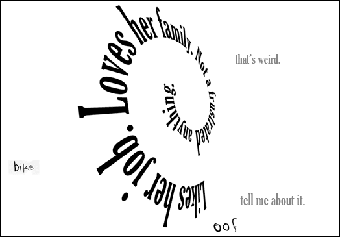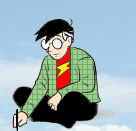Comics Without Pictures?
October 9th, 2009
 Every once in a while someone gives it a try. Here’s the latest, courtesy of Tim Hall and Jen Ferguson at act-i-vate.
Every once in a while someone gives it a try. Here’s the latest, courtesy of Tim Hall and Jen Ferguson at act-i-vate.
Can there be comics without pictures? Does manipulated, positioned text like this qualify as pictures on some level? Fun questions to ask once in a while.
[Update: Check comments for links to other interesting wordless comics.]
Posted in Experimental Comics














Have you ever come across the poet Kenneth Koch’s ART OF THE POSSIBLE? It’s a collection of his “comics without pictures.”
Some examples.
Great link, Austin. Thanks! Loved the Neil quote they use.
Great Job!!!
All you job is great!
A begin reading Making comics and now i realy fan of your job.
Yeah, that’s an idea a keep coming back to, taking a shot at, and abandoning in failure. My “Panel One” stuff was the closest thing to a success, and that was pretty goofy stuff.
I can’t say I’m wowed by this one. I do like how they’re using the positioning of the smaller bits of dialogue to indicate the movement of the speakers, but I find the text manipulations pretty uninteresting. Not that I haven’t played with that method myself, but I’ve never found it very satisfactory.
I would say, though, that as soon as you start using the text as a visual element, it does become a form of picture. So it’s really not “comics without pictures” that I’m interested in, so much as “text as image,” which is really a pretty fundamental characteristic of comics in the first place.
Panel One
I think I appreciate this more as a frisbee player, than as a comic artist. But I think it’s definitely a fun read.
Some of the words are forming actual pictures, like “bird” on page 7.
Ultimately (pardon the pun) – I think a comic has to have pictures + words.
According to your definition in “Understanding Comics,” I don’t know that it would count as a comic. You defined comics as “Juxtaposed pictorial and other images in deliberate sequence, intended to convey information and/or produce an aesthetic response in the reader.” But then again, you also looked at the Sunday funnies strips that are single panel.
I think comics should be a marriage of pictures and words, so without the pictures it should be classified as something else. Just an opinion.
Yeah I think you need to at least have panels/juxtaposition to have it be a comic.
You get into that “tough to define” area. Lots of poems are written in such a way as to make visual and oral statements. These aren’t pictures but they are designed in part to have a visual effect.
To me, comics have to have pictures, or at least the words form pictures on the page.
I tried my hand at imageless comics with an adaptation of Poe’s “The Raven”, mentioned in this blog about… imageless coimcs:
http://madinkbeard.com/blog/archives/pictureless-comics
My method involved bringing panels together to sometimes suggest images, but no single panel could contain a recognizable image. Panel arrangement and rhythm were also very important.
The Frisbee comic is interesting, but reminds me more of a graphic design school project than comics.
Art Spiegelman, in his Comics 101 lecture, would show a most excellent Harvey Kurtzman strip that was merely black panels and dialogue, but told a story, got a joke across, and made use of panel rhythms to pull it off.
PS: For years now, I have been wanting to create an anthology of “minimalist comics”. Is anyone out there willing to bankroll such a thing?
Derik Badman’s done his own pictureless comics too.
Ah, if only I had money, I’d love to see such an anthology happen. I’d certainly be very interested in contributing to such a project, though.
Pictures and text are both symbols of things, they are one in the same. There is no difference between text and an image in that they each refer to something else. I don’t see why this wouldn’t be a comic, or why there is such a great separation between the two in comics? Think of what Magritte was doing in the 1920’s in art…
But I think what is interesting in these panels is that the object is represented by motion. It’s a playful way of representing an image.
Saying “this is a comic” or “this isn’t a comic” doesn’t really add much to the discussion. What I will say is that the processes going on in this work of art are VERY different from the processes going on in conventional comics. And words ARE different from pictures. The word “cat” does not resemble a cat. It only represents a cat because people invented a system that says it does. The origins of words may have began with pictorial representation, but most languages have evolved into complete abstraction, NOT pictorial representation.
P.S. Obviously, this work of art is muddling up the distinction by using words to create non-linguistic pictorial images and geometric shapes, but the blanket statement that pictures and words are one in the same is detrimental to formal critique.
This example strikes me as playful and enjoyable, sure, but I don’t think it’s breaking any new ground or anything. You pulled something similar to this in Understanding Comics, didn’t you? (Lessee … yeah. Page 87…).
A few years back David Morgan-Mar wrote a big treatise on this strip from his Irregular Webcomic . Interesting discussion, but I think it kind of dodges a bigger (formal) point for “polar bear inna snowstorm” games.
Look at the last piece in Jason Oversby’s Solipsist Doodles mini (Rube Goldberg vs Occam’s Razor – starts on page 20). It makes no pretense to any objective visual storytelling. That is, no pictures – not even suggested as in your example – but the panels retain the rhythmic devices that make comics work.
I always thought Mark Danielewski pulled off the same thing in his House of Leaves. It’s a novel, but he relies so heavily on design as to almost be considered a comic. And Mark Lombardi’s “graphic narratives” use only indexical arrows as a storytelling device, and tell stories only obliquely. But reading between the lines (or, literally, along the lines) produces a definite narrative. Kind of the same mechanics as (mentally) connecting the panels in a comic strip.
These example come from a little outside of comics but are, to me, more formally interesting than this example.
I don’t mean to denigrate this work, though. It’s enjoyable, like I said. And sorry for the multiple replys, this is just something that I’ve given some thought to. I’ve got a text comic in the pipeline for my own web strip that tackles this formal issue directly, albeit in a kind of Magritte-y way. I’ll have to push it up in the schedule now, Damn you McCloud!
I would definitely agree that “House of Leaves” has a lot to offer to any discussion of comics free of representational images. I wouldn’t go so far as to say that it *is* comics–but it’s a close cousin at the very least, and it certainly offers a glimpse at the possibility of a truly successful comic built entirely from text.
Don’t forget Gary Dunaier’s “Invisoworld,” from 1987
http://www.amazon.com/Invisoworld-Gary-Dunaier/dp/B00073DWGO
Thanks for the link, Scott! And thanks for all your comments; the links are extremely helpful. I’ll be posting my own thoughts and response soon, over at the act-i-vate blog. My conception of text comics is somewhat different from “pictureless” comics, per se, at least as demonstrated by the links above. (Hint: as some of you noticed, the curving arc of the Frisbee is the key.) More soon. Thanks again, Tim
[…] guru Scott McCloud has opened up a discussion on Experimental comics in general and Uplift The Positivicals specifically. I’ll be writing a […]
It’s not a comic. Not that it’s uncreative or anything, but the above graphic design as well as Panel One, until they get pictures, are not comics.
I guess I have a lot of trouble not considering these as ‘pictures’. When you start futzing around with typography and layout like this (for me) it breaks away from being ‘text’ pretty quickly.
They’ve made pictures. Out of words. No?
Hey look – some pictureless animation: http://www.lycettebros.com/notmytype/nmt04.htm
Obviously, the comic is “picture-izing” words, thus blurring the line between text and pictorial representation. However, the line hasn’t been blurred that much. If you acknowledge these as ‘words’ that look like ‘pictures’, then you are still basically stating that they fit comfortably in the text category. No one has looked at this comic and said, “Hey! These pictures look like words!” Now that would be cool.
P.S. I shouldn’t have used the word ‘comic’ to describe this, huh? Oh well. So much for my fancy point.
I guess my fancy point (such as it is) is that it doesn’t take very much at all to flip it over the tipping point along that continuum. Instead of “words that look like pictures”, I would say “pictures that are made up of words”.
But then I also prefer to call it “splitting of hairs” rather than “hair-splitting”
I grant that there is a continuum, but I feel the ends of the spectrum are very far apart. I admit that to simply state “This is not a comic” ignores that words are images in sequence, but to simply state “This is a comic” risks such a broad definition, I think it becomes counter productive to critical analysis of the medium as it is traditionally understood. Even when the line between abstract language symbols and representational pictures is blurred by an artist, the artist is still acknowledging, and can’t escape the fact that, the line exists. Is bas-relief sculpture? Sure. But thank goodness we have the special term for it. Artistically there is an important conceptual gap between the representation of reality in bas-relief and sculpture that is useful to keep in mind. The same goes for text-based sequential pictures and comics.
[…] out MadInkBeard’s round up of pictureless comics and this post on Scott McCloud’s blog for more ideas of what is and what isn’t a pictureless […]
[…] I’m sure the whole question of what even qualifies as a “picture” will come up, but I’m happy to let others decide that. Posted in Experimental […]